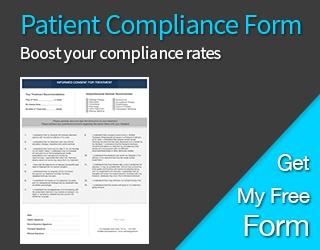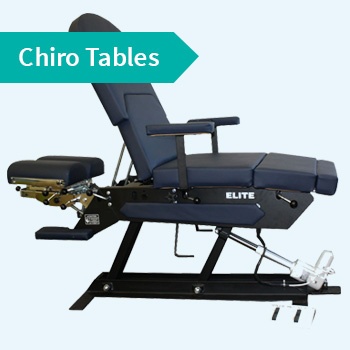
As a healthcare professional, you hope that your patient will follow through on your rehabilitation recommendations after they leave your clinic. Studies show compliance rates to rehabilitation range from 40-91% (Brewer, 2002). Whether you are setting up a physiotherapy clinic or have a super busy massage or chiropractic practice, compliance rates are crucial to boosting your patient's outcome measures which ultimately effects the reputation of your clinic.
How do you ensure that your patients will stick to their treatment program and not fall off after their 3rd appointment with you? The answer is simple. The patient must like and trust you. If you have both of these areas covered, they will adhere to your treatment plans and follow your advice. Here are nine easy ways to boost your patient compliance, from assessment to discharge, that will drive repeat visits.
#1 Listen to your patient
A good relationship starts with good communication. Ask questions, listen effectively, and make a connection with all your patients. It is the duty of the clinician to explain the nature of the injury to the patient. This includes both the expectation and progress of therapy, as well as the importance of adhering to the program. Studies have shown that poor patient-practitioner communication hampers compliance to rehabilitation (Meichenbaum & Turk, 1987). If you want any hope of having your message heard and understood, then you must be a perceptive listener and observe small details that gives you a glimpse into the lives of your patients. Dig deep. Ask your patients about how their pain is affecting their day-to-day lives. Recognize that they often do know their bodies the best. Active listening and inquiry will help you uncover your patient's actual needs and goals, thereby establishing a sense of trust between you and your patient.
Recent evidence supports the theory that biopsychosocial factors, especially the therapeutic alliance, may account for up to 60 percent of a clinical outcome (Hall, 2010). The findings of this study suggest that the alliance between patient/client and therapist positively correlates with clinical outcomes for individuals in physical rehabilitation settings, including treatment adherence and treatment satisfaction (Hall, 2010).
GET YOUR PATIENT COMPLIANCE FORM
Boost your patient engagement today and never lose a patient again.
#2 Get your patient to say yes three times
Requesting your patient for a verbal commitment will increase the likelihood of compliance. You can simply ask, "To maximize your recovery and to return to doing the things you love, can you commit to physiotherapy for 2x/week for at least 6 weeks? Can you commit to spending 10 minutes a day on the exercises I give you?" People tend to follow through on verbal commitments because to go back on a promise would induce a sense of guilt. Getting a commitment shifts the responsibility of reaching rehabilitation goals onto your patient. Commitments are most effective when they are collaborative, active, and internally motivated. Creating manageable objectives and providing feedback throughout the process will result in the patient having a stronger commitment to the recovery process, and will also increase patient compliance.
Also have you heard of the Three Yeses? If you say yes three times you'll find that you are very much more tempted to say yes a fourth time. You can obviously use this to get someone to agree with you. Do you want to feel better? Do you want to return to doing the things you love? Can you commit to doing your daily exercises? Can you commit to your treatment plan for at least 6 weeks?
#3 Create a positive healing environment
What comes to mind when you think of a positive and optimal healing environment? A Japanese zen garden? A spa? Does your clinic come to mind, perhaps? There is growing evidence that a positive environment can reduce stress and anxiety that ultimately affects our health. Create a positive atmosphere in your clinic that provides a pleasant support staff, knowledgeable and approachable therapists, as well as a limited wait time. A positive, interactive, and empathetic environment can promote harmony of the body, mind, and spirit. Furthermore, a positive healing environment will mean patients are more likely to return, will feel confident in your care, and believe that they can and will most definitely recover.
#4 Be culturally sensitive
Not all patients are the same. Healthcare professionals interact with patients from a wide range of ethnic and socio-cultural backgrounds and need to be aware and cognizant of cultural sensitivities. This awareness is vital to building and maintaining a strong therapeutic alliance. Studies have shown that to establish trust between the therapist and patient, factors such as lifestyle, family, living circumstances, and socio-cultural context must be integrated into the treatment plan. Being sensitive to issues regarding culture, race, gender will enhance both patient experience and patient compliance.
#5 Make home exercise program fun
You provide your patients with a home exercise plan, and far too often they don’t follow through with the exercises when they are at home. Or even worse, they misplace the exercise sheet and the piece of thera-band. While home exercise programs are imperative to recovery, they are often neglected. Why is this such a common issue for a physiotherapist? Often, patients are not confident in their understanding of the exercises or how to execute proper techniques. Furthermore, some therapists prescribe way too many exercises making it difficult for the patient to manage within their day to day activities. Make your efforts count! Stress to your patients that the home exercise programs are an extension of your treatments and they need to play an active role in their recovery. Emphasize that the home exercise program and the therapy sessions work together to achieve rehabilitation success. To increase the likelihood of patient participation, make the home exercise program engaging and user friendly. Provide the patient with a multimedia program where they can access demonstrations, pictures and videos of their exercises. Taking into account your patients' learning styles, they'll then have resources that help them follow along and complete their individualized program.
#6 Automate your appointment reminders
Reminding a patient of their upcoming appointment is a crucial part of ensuring patient compliance. A simple email, phone or text message to patients reminding them of upcoming appointments can increase patient compliance by up to 30 percent. Most practice management software programs, like practice perfect, can automate this process. Alternatively, personalize the reminder by getting your office adminstrator to make a phone call to patients 48 hours before their appointment to reduce no shows and cancellations. Simply put, without the patient, there can be no patient compliance.
#7 Schedule appointments for the next two weeks
After the initial assessment, review the treatment plan with the patient including the frequency of care and duration of treatment. Always walk your patient to the reception area and schedule your therapy appointments with them for the next two weeks. This will get your patient to be committed for the first 4 to 6 visits. Once they have added the appointments in their calandar, you have just boosted your patient compliance rate. At the end of the two weeks, show them how much better they are doing on your re-assessment and book the remainder of their visits as per your original treatment plan.
#8 Use a patient compliance form
Optimize your "consent for treatment" forms to include patient compliance and you will boost your patients commitment in your treatment plan. It has been proven that people are more likely to follow through on a task or duty when they have a verbal or written contract. Spend the extra time to discuss your treatment plan and how you need their 100% commitment if they want full recovery. Sign this form with your patient, along with a witness, to make it official.
On this form, you should address the following:
- frequency of care
- duration of treatment
- re-assessment frequencies
- intergrated treatment plan including physiotherapy, massage therapy, chiropractic, therapy products.
- goals and definition of success
- consequences of not complying with the treatment plan
- delivery of care (if you are using support personnel)
#9 Call your patient the next day
After the first appointment, call your patient the next day to see how they are doing. If they are in pain because you did some treatment on day one or they are unsure about therapy, this would be a great phone call to provide reassurance and to show that you care. You should also implement a patient satisfaction survey after the initial assessment. Using the Net Promoter Score is a good way to measure how happy your patients are with you. Recent evidence supports the theory that biopsychosocial factors, especially the therapeutic alliance, may account for up to 60 percent of a clinical outcome (Hall, 2010). The findings of this study suggest that the alliance between patient/client and therapist positively correlates with clinical outcomes for individuals in physical rehabilitation settings, including treatment adherence and treatment satisfaction (Hall, 2010).
Clinic Supplies Canada has made it super easy for you by providing a sample patient compliance form that is ready for use at your clinic. Hopefully you will find it helpful in boosting patient compliance and repeat vists.
Related Articles
Why Do Patients Self Discharge From Treatment and What To Do About It?
How to Measure Patient Satisfaction and Boost Your Referrals
Supercharge Your Patient Retention with PVA
Clinic Owner Interview Series: #4 Darin Cohen - Why I decided to have business partners
Be Better At The Front Desk: 5 Easy Tactics You Should Know







